Easy Way to Beat Saffron City Gym Master
You don't go to the gym for no reason. You're in the gym, most likely, to accomplish a certain goal. And one of the most common goals in the gym is this: People want to get bigger.
They arrive at the gym chasing bigger muscles, or a bigger frame, and then they do exactly what they think they need to get that goal. The problem: Most people don't really know what they need to do to get bigger.
Ask the average guy in the average gym how to build bigger muscles, and chances are he'll tell you to do exactly what he's doing: Lots of sets and reps of lots of redundant exercises, complete with long breaks to take selfies or scroll through his social media feeds. Or if that guy spends plenty of time on the Internet, he may think high-intensity interval training is the secret to all size (pro-tip: It's not).
Either way, without guidelines, chasing size in the gym isn't easy, which is why there are always plenty of guys training who aren't getting the results they want.
The good news, you don't have to go into the gym blind anymore, thanks to this guide of tips specifically designed to help you get bigger. They mostly borrow from a book by Chad Waterbury, Men's Health Huge in a Hurry , as well as a workout video program by fitness director Ebenezer Samuel, C.S.C.S., New Rules of Muscle.
Ready to get big? Then read on.
This content is imported from poll. You may be able to find the same content in another format, or you may be able to find more information, at their web site.
Lift Big
The longer you've been lifting weights, the heavier the weights need to be in order for you to see results. On one hand, it's a stupidly obvious point — of course you use bigger weights as you become stronger. But it's easier than you think to mess this up.
When you were a beginner, you could gain size and strength as long as the weight you used on any given exercise was at least 60 percent of the amount you could lift for a single max-effort repetition. It's a weight you could lift 15 to 20 times in a single set. By any definition, that's pretty light.
That percentage, though, increases with experience. Most gym regulars need to use at least 80 percent of their 1-rep max to grow bigger and stronger. Now, we're talking about a weight you could probably lift about 8 times in an all-out set before there's nothing left in your tank.
Be honest: Do you really use weights heavy enough to fall into that range? If you typically perform multiple sets of 8 to 10 repetitions for each exercise, you don't. To use 80 percent of your max for 3 or 4 sets, each set would probably consist of 5 or 6 repetitions.
It becomes even harder from there. If you're beyond the intermediate stage — if you're a serious gym rat and have been lifting consistently for much of your adult life, you might need 85 to 90 percent of your 1-rep max to see genuine progress. In a normal workout with multiple sets of each exercise, we're talking about 2, 3, or 4 repetitions per set. You should be failing to finish at least some of those sets, within reason — lifting a weight until you physically can't any more helps to lay the bedrock for success on your next attempt.
You can see the problem: Nobody can lift near-max weights on every exercise of every workout. You'd either burn out or hurt yourself, and it wouldn't take long.
Fortunately, there is one loophole.
Lift Fast
You know you're supposed to lift weights slowly and deliberately and under control. Yes, you should stay "under control" — good form requires it. But there's a serious issue with "slowly and deliberately."
The faster you lift, the better the results. If you're trying to increase size, fast lifts activate more of the muscle fibers that have the most potential to grow. If you're trying to become leaner, fast lifts do more to crank up your heart rate -- and by extension your metabolism — than anything else. And if you're trying to grow stronger . . . well, how many feats of strength can you list that are performed slowly and deliberately? Even if something looks slow from the outside, you can bet that the guy performing the feat is trying like hell to get it done as fast as possible.
Anything worth lifting is worth lifting fast, as long as you control the weight and don't let it control you. That means you'll lower the weight a bit more slowly than you lifted it. More on that later.
Quit When You're Ahead
A fast lift with a heavy weight uses more muscle fibers than a slower lift with a lighter weight. But those big, strong muscle fibers poop out really fast — usually in 15 seconds or less. Once they've quit on you, you're left to struggle with the weight using fibers that aren't up to the task.
Your body has two ways of tipping you off:
1. The speed of your repetitions slows.
2. Your form changes, and you either shorten your range of motion or have to cheat to accomplish the full range.
At that point, it makes more sense to end the set than to keep going with compromised speed or bad form — think of those as your new standards for a failed rep.
Yes, it can feel unnatural. After all, if the goal is to do sets of 8 reps and your speed slows down on the sixth, it takes discipline to end the set before grinding and shaking through those seventh and eighth reps.
Focus on Big Muscles
Yes, biceps curls will help grow your biceps. But the biceps curl can't and shouldn't be the backbone of your workout. Moving big weights is what will help you get bigger overall, forcing your entire body to grow.
That means focusing on tentpole lifts: Bench presses, pullups and chinups, barbell rows, deadlifts, and squats. Aim to do at least one of those moves in every workout. It should be one of your first two exercises each day, too, so that you're strongest and freshest and ready to move heavy weight. If you leave big exercises for too late in your workout, you simply don't have the energy to move the same loads.
So build your workouts with your biggest lifts first. Take the chest workout below. It starts with a basic dumbbell press, the heaviest exercise in the routine. There are detail motions, like cable flies, near the end, only after the larger muscles have fatigued.
Build your workouts with your biggest exercises first, and you'll thrive.
Crush Leg Day
You know to focus on your biggest muscles, and the muscles that can move the most weight. And no set of muscles moves more weight than you legs. From bodybuilders to CrossFitters to powerlifters, almost every regular gym-goer has a squat and deadlift that's easily much stronger than, say, their bench press or their shoulder press.
That's why you can't skip leg day (just in case the "don't skip leg day" memes weren't enough to get that point across). And you can't mail in leg day, either. When you get into the gym to train legs, train them hard and aggressively. You should be training them as heavy as you can with good form. And, unless you have knee issues, you should make sure to master the back squat. This video can get you started on that road.
Perfect Your Technique
All this talk of lifting heavy doesn't mean you should be bouncing weights off your chest when you bench press, or piling up kipping pullups, or doing half-squats with heavy weight.
You want to move heavy weight with precision, not momentum! And that means learning how and when to use pauses and stops so that you insure that your muscles are doing the work. And it means learning to lift with specific tempos. You're always aiming to lift your weights fast, but lowering the weights? That's another story.
Take a squat for example. You want to stand up as powerfully and aggressively (and quickly!) as possible. But when you sit down, take your time. Think about descending into the bottom of your squat in a controlled manner that takes 2 seconds. Then hold the bottom position for 1 second. Then stand up.
Learning to do reps this way will help you build muscle and body control. Just as importantly, it'll help you build a strong mind-muscle connection, helping you understand the muscles you're supposed to be activating on each lift. Need more ways to really activate that mind-muscle connection? Try these biceps moves from New Rules of Muscle.
Let Cardio Take a Back Seat
Yes, it's good to train your cardiovascular system. And yes, if you want to shed fat, you need to burn calories. But if you're trying to get bigger, you need to maintain that focus.
One common mistake people make when trying to pack on size: they keep trying to integrate cardio into the workouts. But that just may hinder your ability to put on size.
If you badly want to gain size fast, then focus on size first. That means lifting heavy, then letting your body recover from those heavy lifts so you can lift heavy again. And that recovery gets hindered if you lift heavy, then spend a half-hour running on the treadmill instead of recovering properly.
There will be time to train your cardiovascular systems later, after you have the size you've been chasing.
Recover
True story: More training is not always better. You break down muscle tissue in the gym; that tissue grows back when you're not training. So while it's tempting to train as hard as possible for as long as possible, that's not going to get you the gains you think it will.
Your best training approach, especially if you're just starting out on your fitness journey: Aim to get a good, hard workout that has you moving heavy weights every other day. So you might train on Monday then rest Tuesday, train again Wednesday then rest Thursday.
Training every day can be done, and once you get advanced in the gym, there's a purpose to that. But if you start doing that at the start of your fitness journey, you may gradually see your performance in the gym diminish. It's better to be fully rested between workouts, so that you can attack each workout vigorously.
Cut Class
Fitness classes are all the rage these days, but if you're trying to get bigger and stronger, that isn't the way to go. Your typical one-hour fitness class isn't built to help you gain muscle; it's set up to help you burn calories and get a good sweat on.
If you want to gain muscle and size, you need two things that fitness classes can't provide. First off, you need plenty of rest between sets. Remember: You're lifting heavy. And you can't lift heavy if you have 15 seconds to gather yourself before you need to hit your next set of . . . whatever. Second, you need a program that targets specific muscles. Showing up to a spin class or a boxing class isn't going to get that done.
Those classes are fine if your goal is general fitness. But if you truly want size? You need to cut fitness classes from your training regimen.
The World's Smartest Workout
If you want to pack on muscle fast, the old saying is true: You need to train smarter, not harder. Try this workout to get you started.
Monday
Do 25 total reps of each exercise, using a weight you can lift 4 to 6 times before your speed slows down or your form changes. Rest about 60 seconds between sets.
1. Bench press
2. Inverted Row
3. Deadlift
Tuesday: Rest
Wednesday
Do 40 total reps of each exercise with each arm or each leg, using a weight you can lift 10 to 12 times before your speed slows down or your form changes. Do all the reps of each exercise before resting. Rest 45 seconds between sets.
1. Dumbbell mixed-style incline press (do 4 full clusters of reps, instead of 10 to 12 reps)
2. Dumbbell single-arm row
3. Kettlebell Rotational Lunge To Walking Lunge (do 6 reps per leg)
Thursday: Rest
Friday
Do 15 total reps of each exercise, using a weight you can lift 2 to 3 times before your speed slows down or your form changes. Rest about 90 seconds between sets.
1. Mixed-style dumbbell rows (do 4 clusters per side)
2. Skullcrusher
3. Front Squat
Ebenzer Samuel, C.S.C.S., is the fitness director of Men's Health and a certified trainer with more than 10 years of training experience. He's logged training time with NFL athletes and track athletes and his current training regimen includes weight training, HIIT conditioning, and yoga. Before joining Men's Health in 2017, he served as a sports columnist and tech columnist for the New York Daily News.
Source: https://www.menshealth.com/fitness/a19534319/5-fast-rules-bigger-leaner-stronger/

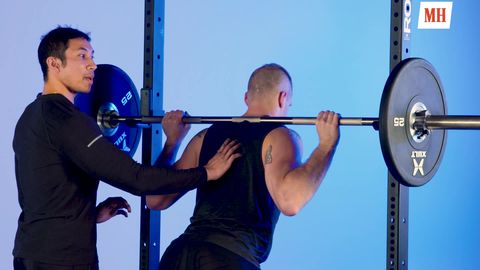

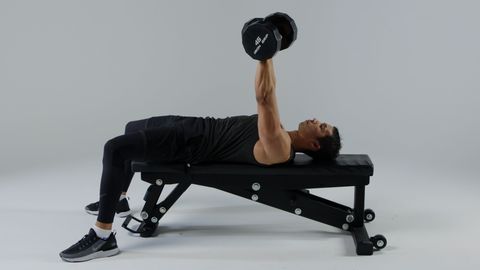
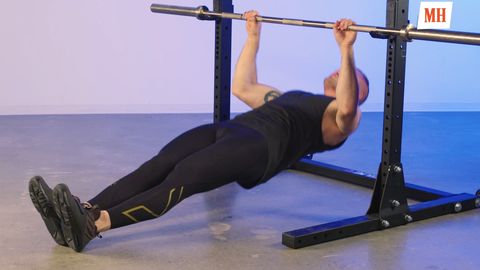
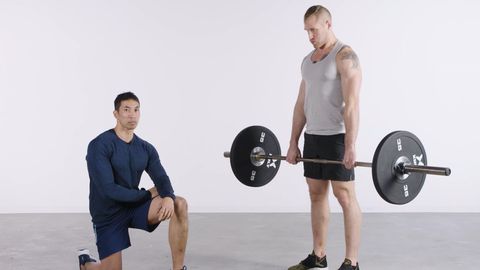

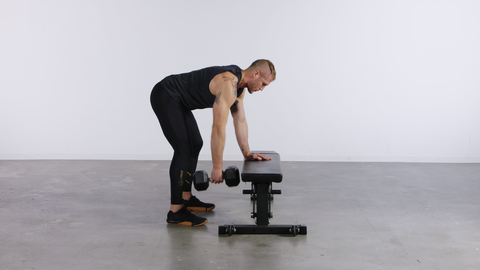


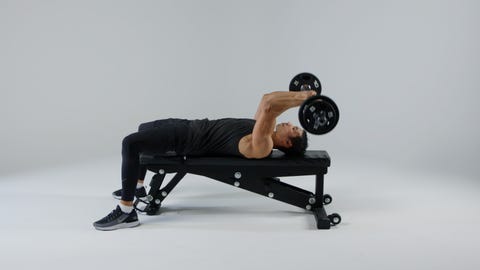

0 Response to "Easy Way to Beat Saffron City Gym Master"
Post a Comment